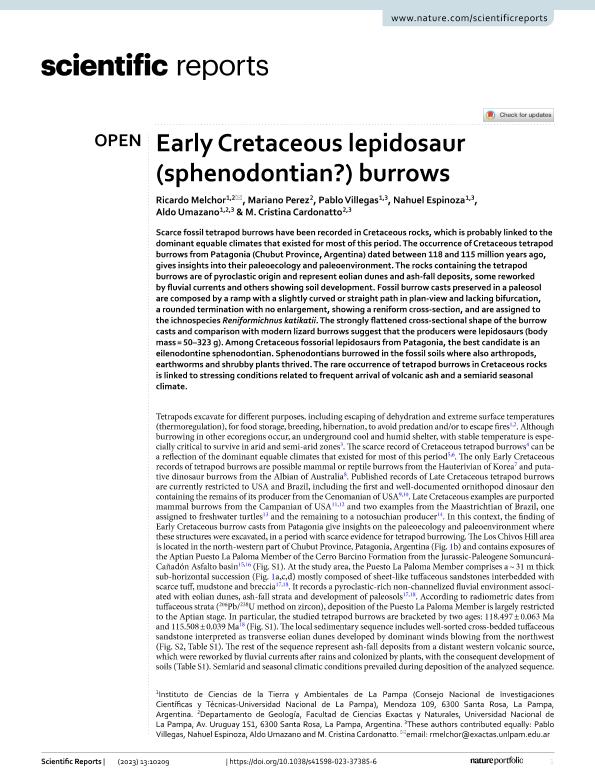Artículo
Early Cretaceous lepidosaur (sphenodontian?) burrows
Melchor, Ricardo Nestor ; Perez, Mariano; Villegas, Pablo Martin
; Perez, Mariano; Villegas, Pablo Martin ; Espinoza, Nahuel Ezequiel
; Espinoza, Nahuel Ezequiel ; Umazano, Aldo Martin
; Umazano, Aldo Martin ; Cardonatto, M. Cristina
; Cardonatto, M. Cristina
 ; Perez, Mariano; Villegas, Pablo Martin
; Perez, Mariano; Villegas, Pablo Martin ; Espinoza, Nahuel Ezequiel
; Espinoza, Nahuel Ezequiel ; Umazano, Aldo Martin
; Umazano, Aldo Martin ; Cardonatto, M. Cristina
; Cardonatto, M. Cristina
Fecha de publicación:
06/2023
Editorial:
Springer
Revista:
Scientific Reports
ISSN:
2045-2322
Idioma:
Inglés
Tipo de recurso:
Artículo publicado
Clasificación temática:
Resumen
Scarce fossil tetrapod burrows have been recorded in Cretaceous rocks, which is probably linked to the dominant equable climates that existed for most of this period. The occurrence of Cretaceous tetrapod burrows from Patagonia (Chubut Province, Argentina) dated between 118 and 115 million years ago, gives insights into their paleoecology and paleoenvironment. The rocks containing the tetrapod burrows are of pyroclastic origin and represent eolian dunes and ash-fall deposits, some reworked by fuvial currents and others showing soil development. Fossil burrow casts preserved in a paleosol are composed by a ramp with a slightly curved or straight path in plan-view and lacking bifurcation, a rounded termination with no enlargement, showing a reniform cross-section, and are assigned to the ichnospecies Reniformichnus katikatii. The strongly fattened cross-sectional shape of the burrow casts and comparison with modern lizard burrows suggest that the producers were lepidosaurs (body mass = 50–323 g). Among Cretaceous fossorial lepidosaurs from Patagonia, the best candidate is an eilenodontine sphenodontian. Sphenodontians burrowed in the fossil soils where also arthropods, earthworms and shrubby plants thrived. The rare occurrence of tetrapod burrows in Cretaceous rocks is linked to stressing conditions related to frequent arrival of volcanic ash and a semiarid seasonal climate.
Palabras clave:
BURROWS
,
EARLY CRETACEOUS
,
PATAGONIA
Archivos asociados
Licencia
Identificadores
Colecciones
Articulos(INCITAP)
Articulos de INST.D/CS D/L/TIERRA Y AMBIENTALES D/L/PAMPA
Articulos de INST.D/CS D/L/TIERRA Y AMBIENTALES D/L/PAMPA
Citación
Melchor, Ricardo Nestor; Perez, Mariano; Villegas, Pablo Martin; Espinoza, Nahuel Ezequiel; Umazano, Aldo Martin; et al.; Early Cretaceous lepidosaur (sphenodontian?) burrows; Springer; Scientific Reports; 13; 1; 6-2023; 1-13
Compartir
Altmétricas



